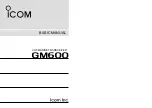
– –
– –
98
99
utilisateurs, il faut choisir le type d’antenne et son gain de sorte que la
puissance isotrope rayonnée équivalente (p.i.r.e.) ne dépasse pas l’intensité
nécessaire à l’établissement d’une communication satisfaisante.
Le présent émetteur radio (HUM-A-900-PRO-CAS) a été approuvé par
Industrie Canada pour fonctionner avec les types d’antenne énumérés la
Figure 107 et ayant un gain admissible maximal et l’impédance requise
pour chaque type d’antenne. Les types d’antenne non inclus dans
cette liste, ou dont le gain est supérieur au gain maximal indiqué, sont
strictement interdits pour l’exploitation de l’émetteur.
Figure 107: HumPRO-A
TM
Series Transceiver Approved Antennas
Product Labeling
The end product containing the HUM-A-900-PRO-UFL or
HUM-A-900-PRO-CAS must be labeled to meet the FCC and IC product
label requirements. It must have the below or similar text:
Contains FCC ID: OJM-HUMA-900 / IC: 5840A-HUMA900
The label must be permanently affixed to the product and readily visible to
the user. ‘‘Permanently affixed’’ means that the label is etched, engraved,
stamped, silkscreened, indelibly printed, or otherwise permanently marked
on a permanently attached part of the equipment or on a nameplate of
metal, plastic, or other material fastened to the equipment by welding,
riveting, or a permanent adhesive. The label must be designed to last
the expected lifetime of the equipment in the environment in which the
equipment may be operated and must not be readily detachable.
FCC RF Exposure Statement
To satisfy RF exposure requirements, this device and its antenna must
operate with a separation distance of at least 20cm from all persons and
must not be co-located or operating in conjunction with any other antenna
or transmitter.
Antenna Selection
Under FCC and Industry Canada regulations, the HUM-A-900-PRO-UFL
and HUM-A-900-PRO-CAS radio transmitters may only operate using
an antenna of a type and maximum (or lesser) gain approved for the
transmitter by the FCC and Industry Canada. To reduce potential radio
interference to other users, the antenna type and its gain should be so
chosen that the equivalent isotropically radiated power (e.i.r.p.) is not more
than that necessary for successful communication.
The HUM-A-900-PRO-UFL and HUM-A-900-PRO-CAS radio transmitters
have been approved by the FCC and Industry Canada to operate with the
antenna types listed in Figure 107 with the maximum permissible gain and
required antenna impedance for each antenna type indicated. Antenna
types not included in this list, having a gain greater than the maximum gain
indicated for that type, are strictly prohibited for use with this device.
Conformément à la réglementation d’Industrie Canada, le présent émetteur
radio peut fonctionner avec une antenne d’un type et d’un gain maximal
(ou inférieur) approuvé pour l’émetteur par Industrie Canada. Dans le but
de réduire les risques de brouillage radioélectrique à l’intention des autres
Antennas / Antennes
Linx Part Number
Référence Linx
Type
Gain
Impedance
Impédance
Valid For
Tested Antennas
ANT-916-CW-HWR-RPS ½ Wave Dipole Helical
1.2dBi
50
Ω
Both
ANT-916-USP
¼ Wave Planar
0.3dBi
50
Ω
–CAS
Antennas of the same type and same or lesser gain
ANT-916-CW-HW
½ Wave Dipole Helical
1.2dBi
50
Ω
Both
Cable Assemblies / Assemblages de Câbles
Linx Part Number
Référence Linx
Description
CSI-RSFB-300-UFFR*
RP-SMA Bulkhead to U.FL with 300mm cable
CSI-RSFE-300-UFFR*
RP-SMA External Mount Bulkhead to U.FL with 300mm cable
* Also available in 100mm and 200mm cable length










































